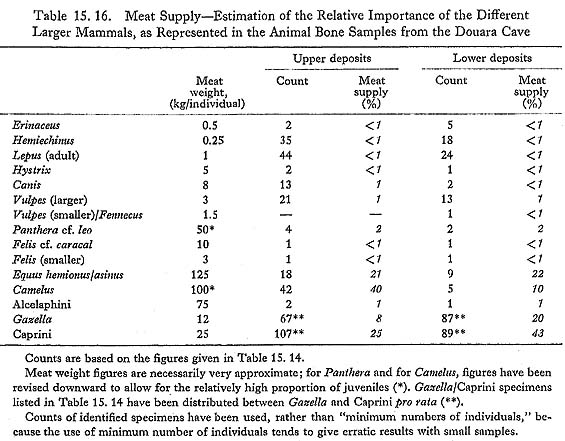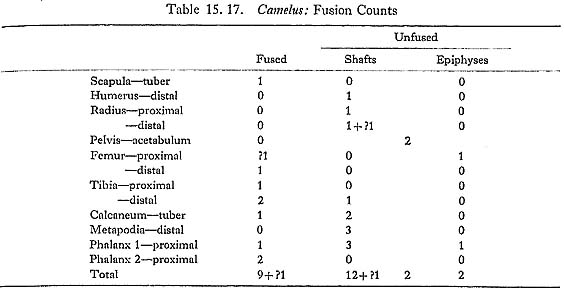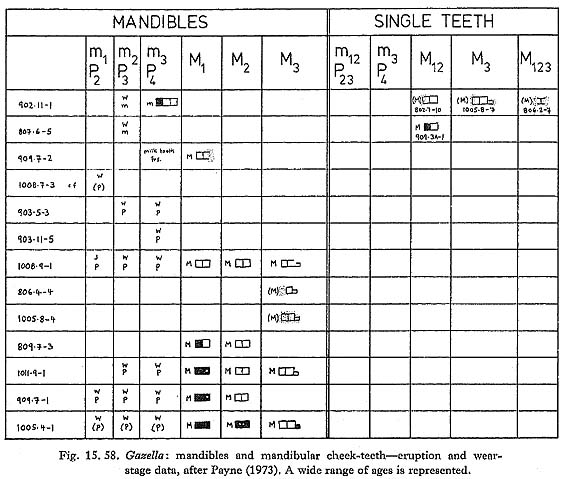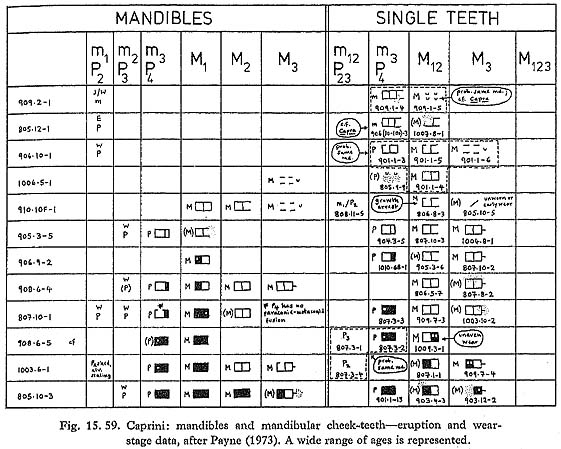CHAPTER 15
The Animal Bones from the 1974 Excavations at Douara Cave
Sebastian Payne
Trinity Collage, University of Cambridge
| ( 9 / 10 ) |
15. 3. 4 Human subsistence at Douara CaveAs discussed above, the smaller mammal bones (Components A and B of the sample; p. 78) are taken not to be human food remains, but to be the remains of bats that died in the cave and the remains of owl pellets. Only the larger mammals (Component C) are taken to be human food remains; and the size cut-off between these and the smaller mammals is relatively sharp. The smallest animal that clearly belongs with Component C is Hemiechinus, which weighs around 400-500 gm (Flower, 1932); and the largest animal that clearly belongs with Components A and B is Psammomys, which weighs around 100-200 gm (Osborn and Helmy, 1980). This presumably reflects the smallest size of animal that was hunted and thought worth bringing back to the cave. Making necessarily approximate estimates of the amount of meat provided by different animals, Table 15. 16 attempts to compare the relative amounts of meat provided by the different species represented among the human food remains found in the cave. Such calculations suffer from many sources of possible error. Apart from biases introduced by differential preservation, by differential recovery, and by the different numbers of such bones as phalanges and metapodia in the skeletons of different animals, it is also the case that smaller animals tend to be underrepresented because they are mote likely to be eaten at once when caught, and very large animals tend to be underrepresented because they are too large to carry back to the cave as whole carcasses or as quarters "on the bone." Meat may be stripped off the skeleton and brought back without bones, or the group may move to camp at the kill-site. Subject to these necessary reservations, Table 15. 16 indicates that the larger herbivores-Equus, Camelus, Gassella and Capl'ini-provided more than 95% of the meat supply at Douara Cave. Carnivores account for a very small fraction of the total; whether they were eaten, or only hunted for skins, has relatively little effect on the figures. Smaller animals, such as hares and hedgehogs, also make up only a small proportion of the total, but the figures may underestimate their importance, both because they are more likely to be eaten as soon as caught and because a regular supply of smaller animals provides a more consistent food supply than the occasional large carcass, which may rot before it can be finished and which leaves long hungry gaps between successful hunts. Larger birds probably also contributed to the diet, but not as a major resource: further consideration must await the specialist report. Eggs were also presumably eaten, but the amount indicated by the relatively small number of eggshell fragments is not very large. Comparison of the figures for the lower and upper parts of the deposit shows a shift from more Gaxsella and Caprini in the lower deposits to more Camelus in the upper deposits.
Large samples can provide information about hunting and butchery techniques and about seasonality of occupation, based on the relative representation of different parts of the skeleton, of different age groups and of males and females. Once any single species is considered, however, the relatively small size of the Douara Cave sample can provide only very limited indications: Hemiechinus: Most of the bones are from adults (i.e. dentition fully erupted, epiphyses fused); there are a few older juveniles, including 3 mandibles with P4 erupting (the 25 edentate mandibles nearly all had full erupted dentition). The relative representation of different parts of the skeleton (Table 15. 11) is markedly uneven, with mandibles, humeri and ulnae showing high counts, and many other parts of the skeleton showing very low counts; but this unevenness probably reflects preservation (e.g. shortage of maxillae) and recovery (e.g. shortage of carpals, tarsals, metapodia and phalanges) biases. Lspus: The different distributions shown by young juveniles and adults (Figs, 15. 53-55) has already been discussed (p. 65); it is suggested that only the adults were hunted by man. The relative representation of the different parts of the skeleton again, shows some recovery bias (low counts for phalanges 2 and 3); the apparently high counts for metapodia and phalanx 1 reflect their frequency in the skeleton. Eqmis: Most of the specimens are from adults, but juvenile specimens include an unfused distal tibia, an unfused distal metapodial and three milk teeth-a milk incisor and an upper milk molar in very early wear, and an upper milk molar in full wear. The relative abundance of teeth probably reflects preservation bias (see below).Camelus: In contrast to the other larger mammals, many of the camel bones are from very young animals: not only are epiphyses unfused (Table 15. 17), but the bones are strikingly small, and their surfaces look very young. Young animals may have been even commoner relative to adults than the figures indicate, as their bones are relatively fragile and easily destroyed; the counts given do not include a number of very juvenile shaft fragments, including at least 11 metapodial shaft fragments with incomplete fusion between the third and fourth metapodia (for comparison, there were 2 adult metapodial shaft fragments). Clearly, larger samples are needed; but the available data could be taken as suggesting selective hunting of very young camels, either deliberately-perhaps because adults were too difficult or too dangerous to hunt-or because young animals were more vulnerable to the hunting methods in use (compare similar suggestions by Klein [1978] for samples of Syncerns and Pelorovis with high frequencies of very young animals from Stone Age sites in South Africa). An alternative possibility, in view of the large size of adult camels, is that adults were too large to bring back to the cave (though the samples include an adult distal femur and proximal tibia), and that they were usually defleshed, and possibly eaten, at the kill-site. The relative shortage of camel teeth, as compared with the other large mammals, might reflect the fragility of juvenile teeth in general, and of camel teeth in particular, or it might suggest that heads were often left at the kill-site.
Gaselier. Most of the bones are from adults. The 13 mandibles (Fig. 15. 58) cover a wide range of ages: 3 still have their milk molars, the rest are older, and include 1 mandible in advanced wear. Of the 7 horncores, 4 are male and 3 female. The relative abundance of teeth (even after allowance has been made for the relative anatomical frequencies of teeth and other parts of the skeleton) probably reflects preservation bias.
Caprini: As with Gamella, most of the bones are from adults. In Caprini, milk molars are replaced by premolars around the end of the second year. Of the 12 mandibles, only 1 has milk molars; the rest are older. The ratio of third milk molars to fourth premolars, including loose teeth, is 2: 13 (Fig. 15. 59). These data suggest that few animals were killed before the end of the second year, but it should be remembered that the teeth of very young animals are relatively fragile, and that these may be underrepresented. Molars show a wide range of wear-states, and include some that must be from fairly old animals: 8 of the 25 first and second lower molars have the anterior infundibulum erased, as probably did 2 of the 13 lower third molars. As with Gassella, teeth and mandibles are relatively more common than the other parts of the skeleton, and this is taken to reflect preservation bias; recovery bias can also be seen, as already discussed (p. 84, Table 15. 7).
Only in Camelus, therefore, is there any suggestion that the relative representation of the different parts of the skeleton may indicate differences in treatment of different parts of the skeleton: preservation and recovery bias provide adequate explanations for the relative representations of different parts of the skeleton seen in the other animals and suggest, even though samples are small, that these animals were brought back complete to the site. Even the largest of these, Equns hemionusfasinus, was fairly small; a dressed-out carcass would probably have weighed 100-150 kg (including the bones), but quarters would have made manageable loads. Again, apart from Camelus, as discussed above, most of the animals were adult, and a wide range of ages is represented. There is no suggestion ofoncentration on or selection for a particular age group, and, in the case of Gasella, the limited data show no evidence for selection of males or females; there is therefore no suggestion of any move toward domestication even in the widest sense. In the case of Camelus, hunting may have been selective, but this is not the only possible interpretation of the limited data available. Some very juvenile animals are present in the sample; little can be said, however, about seasonality of occupation of the site on this basis, partly because larger samples are needed, and partly because breeding seasonality is very much less restricted and predictable in warm, semi-arid climates than in more northerly areas. So far, this discussion of human subsistence has been concerned almost entirely with the meat represented by the animal bones found in the cave; and while this is all that we have direct evidence for, it probably gives only a very partial picture of the diet of the people who used the cave. One reason for this limited picture is poor preservation. Preservation at most archeological sites is probably poorer than is recognized: sedimentation rates are generally slow, and in most climates anything of plant or animal origin that lies around on the ground surface or close to it for any length of time will disintegrate. Bones are relatively resistant to destruction, and thus the part played by meat in prehistoric diets is inevitably exaggerated; plant remains are very rapidly destroyed unless accidentally burnt. At Douara Cave there is evidence for some destruction of bone (p. 81, pp. 99-101), and plant remains are scarce: the seeds of Boraginaceae tentatively recognized from the Middle Paleolithic occupation, unusual among seeds in having a siliceous pericarp and probably only preserved for this reason, are unlikely to be food remains, as this family includes some herbs and dye-plants, but no plants normally regarded as food resources. Plant remains also tend to be underrepresented in archeological contexts because many edible parts of plants, such as tubers, bulbs and rhizomes, are unlikely to leave any remains ; also many kinds of food obtained from plants require little or no preparation or cooking, and so may be eaten as they are collected, away from the site. At the same time, the dry, open, steppe environment around the cave, as indicated by the mammal remains, probably offered relatively little in the way of food plants. Of the perennials that would probably have been dominant, only the grasses would have provided a useful resource: Stipa and other similar grass seeds would be edible, but these require some preparation. Certain bulbs and tubers might have offered more, but these may not have been abundant: they are the main food of Spalax, and Spalax is relatively rare among the small mammal remains. Of the trees that might have been found in the small scrub patches that are probably indicated, Juniperus is of little food value, and most species of Pistacia provide relatively little food. It can therefore tentatively be concluded that plants are likely to have played only a minor part in the diet of the occupants of the cave. Water supply must also have presented an acute problem for most of the year in the area of the cave: the wadis dry rapidly after rain, and while some water could probably be found by digging in suitable places in the wadi beds for some time after it had rained, such supplies would probably not have lasted long into the summer. The ostrich eggshell fragments found in the cave might be the remains of containers used for carrying and storing water, and skins could also have been used for this purpose, but the closest source of water during the driest part of the year would probably have been around 20 km away, obtained either at the Palmyra Oasis or by digging below the lowest parts of the Sabkhet Mouh. All of these conclusions suggest that the Douara Cave is unlikely to have been occupied throughout the year-which is also suggested by the relatively small amount of bones and flints found in the cave and by ethnographic parallels. Hunter-gatherers in such environments are typically mobile and opportunist, moving to another place with better prospects once the food supply around the current camp-site decreases too far. So little is known, however, about other contemporary sites in this part of Syria that it is possible only to speculate briefly about the possible relationship between Douara Cave and other sites. Douara Cave was probably most inviting near the end of the winter rains, when grazing would still have been reasonably good, grazing animals would have been most numerous and in good condition, grasses and other plants would have been in seed, and water would still have been fairly readily available. During the long, dry summer and autumn, two choices would have been open to the inhabitants of the cave: to camp at oases such as Palmyra (where a number of Middle Paleolithic surface scatters have been found [Hanihara and Akazawa, 1979: 202-203]), or to move north or west to wetter areas. Occupation of the cave was not necessarily on any regular basis: the total of flints and bones found is tiny in relation to the tens of thousands of years during which they may have accumulated, and the cave may only have been occasionally used-in a year withmore winter rain than usual or when unusual conditions elsewhere led people to move outside their usual territory. These speculations need more data before they can usefully be tested, however. A final question, and one to which no very satisfactory answer is offered, is: Why was the cave not occupied more intensively during the wetter period (or periods) that have been postulated when the Palmyra Basin pluvial lake was at its maximum? One possibility is that this was at an earlier period-but this runs counter to the available dates for the lake. A second possibility is that the cave was not used because lake-edge camp-sites were preferred-against this, however, is the lack of surface sites on the lake edge (Hanihara and Akazawa, 1979: Fig. 14. 2). A third possibility is that any wetter period was only of very brief duration, and that the high stand (or high stands) of the lake reflects ho more than one or a few years of unusually high rainfall, enough to create a short-lived lake, but not enough to cause any marked ecological shifts. |



